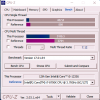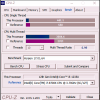- Jul 27, 2020
- 27,822
- 19,022
- 146
Managed to spend some quality time with this laptop at the office. It was going to someone else but I asked the IT guy to let me have it for a few hours.
First, let's get the physical attributes out of the way. The build is pretty sturdy. It looks and feels like a hunk of metal. Thanks to being fairly heavy, it would definitely work as a murder weapon with a blow to the head. The silver metallic (probably some alloy) casing doubles as a heatsink and radiates the heat of the internal components pretty well. I think I heard the fans ramp up for a few seconds once or twice at most, despite benchmarking on it for hours. Honestly, that was surprising. The kind of experience I would have expected from an AMD laptop, not an Intel one. So kudos to HP on that.
The display wasn't anything out of the ordinary. Just a run of the mill 45% NTSC, as far as I could tell. Possibly IPS (don't remember angling the lid too much to get a better view). The keyboard isn't backlit sadly, something I would have expected at this price point ($842 for 16GB DDR4-3200 RAM, Geforce MX 570 and 1 TB Crucial P3 SSD). Turns out that our regular shop providing laptops to our office gave us a good deal. Other retailers are selling this laptop for the same price with 8GB RAM, 512GB SSD and Geforce MX 550. The keyboard itself is nothing to write home about. Gets the job done. Really wished it was better. Touchpad tapping was fine but the buttons were too hard for my liking.
Didn't have time to update Windows to the latest version.

CPU-Z screenshots of installed memory:
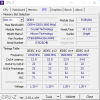
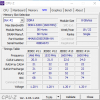
RAM speed was dynamically switching 1T and 2T profiles:
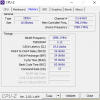
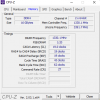
MaxxMem² score: https://forums.anandtech.com/threads/post-your-maxxmem²-score.2608515/post-40919186
Had to be careful inserting a USB flash drive and wired mouse into the USB ports. They were not easy to plug into. I think this is a problem plaguing most metallic laptop builds, as I faced the same issue with my old ASUS N550JV.
Plugged in and on battery power plan was set to High Performance.
The dGPU:
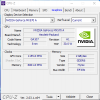
Windows was freshly installed by IT and he forgot to install the Geforce driver so downloaded it from Nvidia's site and installed it. The MX 570 GPU showed up in Device Manager and was also used by Unigine Superposition on the first run and after enabling Max DC performance (see below for more on that):


The dGPU has 2GB of its own VRAM but it can use up to 6GB from the system RAM for a total of 8GB. Couldn't do anymore testing with Unigine Superposition on subsequent reboots post Max DC performance enabled as Unigine stopped seeing the dGPU and would only show the iGPU.
Out of box Geekbench 5 score: https://browser.geekbench.com/v5/cpu/19537637
I went into the BIOS looking to disable the E-cores but HP doesn't provide that option. With only two P-cores in this CPU, maybe Intel and/or HP don't want support call headaches from people insisting that their CPU had 12 cores yesterday and suddenly 8 of those have vanished! I did find something called Max DC performance (something to do with plugged in turbo boost?) so I enabled it and checked GB5 again: https://browser.geekbench.com/v5/cpu/19538591
Max DC perf setting impact on ST: +1.96%
Max DC perf setting impact on MT: -4.69%
I decided to leave this setting on as the ST score is comparable to the Core i5-12400 and it's nice to know that I'm getting desktop class ST performance. The only other thing I could change now was to turn off HT so here's the new GB5 score: https://browser.geekbench.com/v5/cpu/19539457
Comparison with stock
Disable HT impact on ST: +5.63%
Disable HT impact on MT: -18.07% (!)
Comparison with HT on and Max DC perf
Disable HT impact on ST: +3.6%
Disable HT impact on MT: -14.04%
No matter how you look at it, disabling HT on the two P-cores has a significant impact on MT performance. I guess in most cases, HT should be left on, at least for this CPU.
Next up is Rapydmark on High setting: https://forums.anandtech.com/threads/rapydmark-cpu-benchmark.2599240/post-40919168
CPU-Z benchmarks show it being comparable to i7-8700K desktop CPU.
Max DC HT enabled

Max DC HT disabled
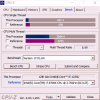
Disabling HT affects both ST and MT here!
First, let's get the physical attributes out of the way. The build is pretty sturdy. It looks and feels like a hunk of metal. Thanks to being fairly heavy, it would definitely work as a murder weapon with a blow to the head. The silver metallic (probably some alloy) casing doubles as a heatsink and radiates the heat of the internal components pretty well. I think I heard the fans ramp up for a few seconds once or twice at most, despite benchmarking on it for hours. Honestly, that was surprising. The kind of experience I would have expected from an AMD laptop, not an Intel one. So kudos to HP on that.
The display wasn't anything out of the ordinary. Just a run of the mill 45% NTSC, as far as I could tell. Possibly IPS (don't remember angling the lid too much to get a better view). The keyboard isn't backlit sadly, something I would have expected at this price point ($842 for 16GB DDR4-3200 RAM, Geforce MX 570 and 1 TB Crucial P3 SSD). Turns out that our regular shop providing laptops to our office gave us a good deal. Other retailers are selling this laptop for the same price with 8GB RAM, 512GB SSD and Geforce MX 550. The keyboard itself is nothing to write home about. Gets the job done. Really wished it was better. Touchpad tapping was fine but the buttons were too hard for my liking.
Didn't have time to update Windows to the latest version.
CPU-Z screenshots of installed memory:


RAM speed was dynamically switching 1T and 2T profiles:


MaxxMem² score: https://forums.anandtech.com/threads/post-your-maxxmem²-score.2608515/post-40919186
Had to be careful inserting a USB flash drive and wired mouse into the USB ports. They were not easy to plug into. I think this is a problem plaguing most metallic laptop builds, as I faced the same issue with my old ASUS N550JV.
Plugged in and on battery power plan was set to High Performance.
The dGPU:

Windows was freshly installed by IT and he forgot to install the Geforce driver so downloaded it from Nvidia's site and installed it. The MX 570 GPU showed up in Device Manager and was also used by Unigine Superposition on the first run and after enabling Max DC performance (see below for more on that):
The dGPU has 2GB of its own VRAM but it can use up to 6GB from the system RAM for a total of 8GB. Couldn't do anymore testing with Unigine Superposition on subsequent reboots post Max DC performance enabled as Unigine stopped seeing the dGPU and would only show the iGPU.
Out of box Geekbench 5 score: https://browser.geekbench.com/v5/cpu/19537637
I went into the BIOS looking to disable the E-cores but HP doesn't provide that option. With only two P-cores in this CPU, maybe Intel and/or HP don't want support call headaches from people insisting that their CPU had 12 cores yesterday and suddenly 8 of those have vanished! I did find something called Max DC performance (something to do with plugged in turbo boost?) so I enabled it and checked GB5 again: https://browser.geekbench.com/v5/cpu/19538591
Max DC perf setting impact on ST: +1.96%
Max DC perf setting impact on MT: -4.69%
I decided to leave this setting on as the ST score is comparable to the Core i5-12400 and it's nice to know that I'm getting desktop class ST performance. The only other thing I could change now was to turn off HT so here's the new GB5 score: https://browser.geekbench.com/v5/cpu/19539457
Comparison with stock
Disable HT impact on ST: +5.63%
Disable HT impact on MT: -18.07% (!)
Comparison with HT on and Max DC perf
Disable HT impact on ST: +3.6%
Disable HT impact on MT: -14.04%
No matter how you look at it, disabling HT on the two P-cores has a significant impact on MT performance. I guess in most cases, HT should be left on, at least for this CPU.
Next up is Rapydmark on High setting: https://forums.anandtech.com/threads/rapydmark-cpu-benchmark.2599240/post-40919168
CPU-Z benchmarks show it being comparable to i7-8700K desktop CPU.
Max DC HT enabled

Max DC HT disabled

Disabling HT affects both ST and MT here!


